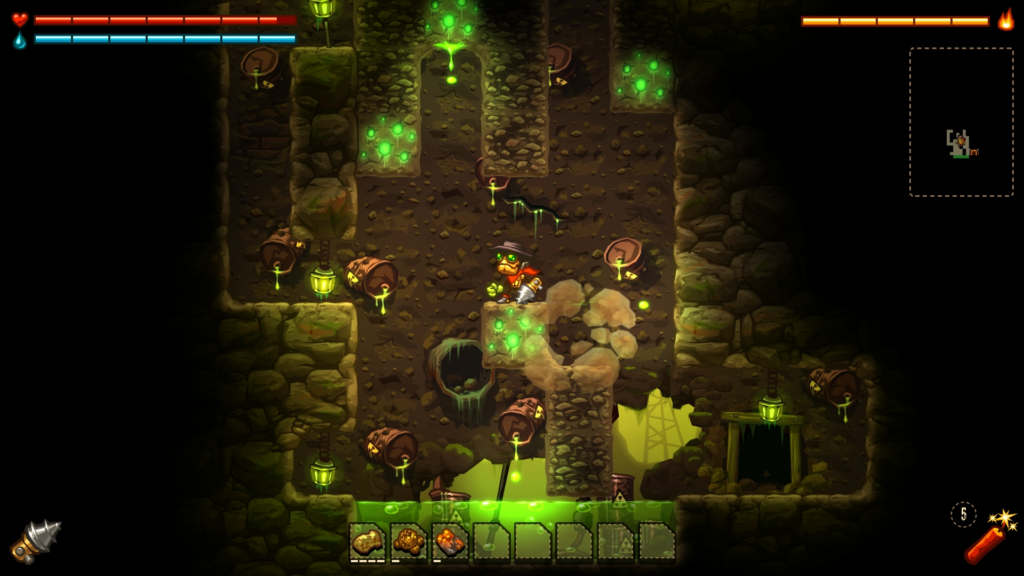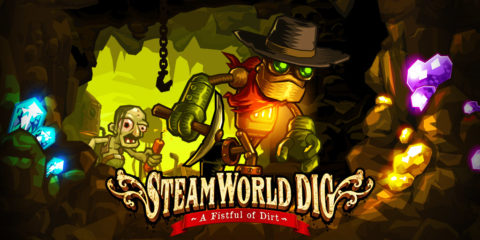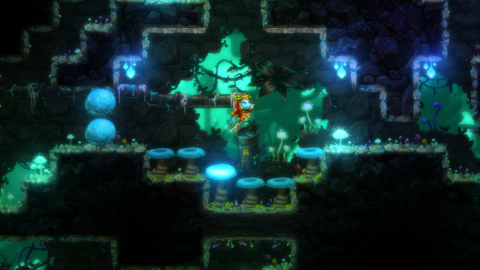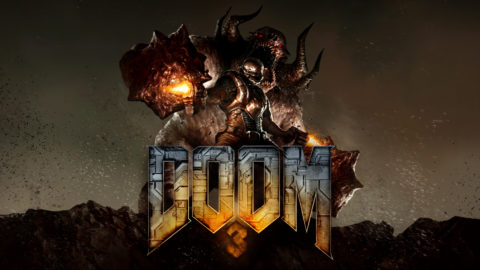
SteamWorld Dig 2 was one of the major highlights of Nintendo’s “nindies” showcase in the last half of 2017. Image & Form’s quirky modular platformer built off the success of earlier entries in the franchise to great acclaim on the Switch.
Thanks to that head of steam (sorry…had to do it,) Switch fans now have access to nearly the full SteamWorld saga on Nintendo’s latest console. Hot on the heels of the recent port of SteamWorld Heist comes the original SteamWorld Dig.
This is a game that has spanned numerous platforms, even beyond Nintendo. SteamWorld Dig has received high praise on both the Nintendo 3DS and PC. Perhaps for the first time on the Nintendo Switch, we’re forced to look at the game against the relative success of a sequel that was arguably meant, in many ways, to be an improvement on the original.
Down in the Mines
Since the original release on the 3DS, SteamWorld Dig has been a colorful game that performed well, and it’s good to see this hasn’t changed for the Switch. Animations are crisp and clean, and the environments are striking and colorful no matter what’s happening on screen.
The controls are responsive and straightforward, and just as comfortable in handheld as they are docked. Some parts of the control scheme feel a little awkward at first, such as pushing down in order to perform steam jumps. Still, on the whole interacting with the game is smooth and enjoyable, and it definitely shines in handheld mode.
SteamWorld Dig first introduced the franchise’s unique brand of do-it-yourself platforming. Using a pickaxe to mine individual blocks, robot miner Rusty has to dig deeper and deeper into his late uncle’s mine, gathering minerals to haul back up and sell. Along the way, he’ll encounter mysterious devices that give him new abilities, and increasingly complex enemies as he works to uncover the mysteries his uncle left below. The underground world is randomized as it loads in, so you’ll never really encounter the same features every time, and it comes with more than a few moments of emergent play that seem purposeful, but likely aren’t.
Overall, the core loop of the game is simple and appealing, but it does get a bit tedious at times. The checkpoints scattered along the dig south feel a bit few and far between, though you can buy deployable ones to make the journey a little easier. Even as you upgrade your pickaxe, a lot of the blocks seem to take a bit too long to crack, forcing you to use other tools that use steam that has to be refilled.
Still, there’s sometime immensely satisfying about the act of carving your own path through the world, and sometimes it creates unique options for taking on tougher enemies or getting around particularly tricky traps. The game does a good job of treating the environment as a puzzle, and I ran into a few moments that required some significant planning before I started to dig. It all adds up to an addictive “tunnel, gather, sell, upgrade” rotation that keeps on giving.
Another World

The setting on display in SteamWorld Dig is proof that Image & Form has had a clear vision of what they want their world to be, even from this earlier stage. The balance of striking color and desolate desert and underground environments creates some memorable and eye-catching moments, even given the relatively simple art style present here.
Character and enemy animations are basic, but blend nicely with the world at large. Everything is clearly defined, and it never feels like too much or too little. Enemies are cartoonish, but instantly recognizable even in the dim light of your ever-fading lamp.
Light is a key element of navigating the underground labyrinth, and it’s put to excellent use in SteamWorld Dig. As your handheld lamp fades, you’ll find it more difficult to navigate the tunnels. Enemies become shadows on the edges of your vision, and every static lamp along the way is an oasis. That being said, its still possible to get around once your lamp runs low, but the world takes on an entirely different look, making even the absence of visuals impressive and engaging.
Sound plays a somewhat less critical role in this, as a straightforward palette of movement, combat, enemy and environmental sounds cover most of the necessities, but not much more. It’s something that feels like a missed opportunity when compared with the rest of SteamWorld Dig‘s worldbuilding tricks, and the western-inspired soundtrack does little to add depth here.
Aside from a few missed opportunity, the game provides a convincing and intriguing world that sets up an equally intriguing story of a world where bots have outlived their creators to carve out a different sort of life in the dust. It’s crafty, colorful, silly, and dark in all the right places, and it’s worth seeing through to the end.
In search of treasures

SteamWorld Dig‘s core gameplay loop is really the main draw here, and the other aspects of the game’s presentation don’t do much to detract from that. Still, there’s not much use for all the riches you haul to the surface unless you have a place to spend that cash.
Driving that core loop is a set of increasingly useful tools that you can buy from a vendor on the surface. It starts out simple, with health refills, lamp and chisel upgrades, and ladders to give you an extra boost down below.
As you delve deeper, though, you’ll get access to things like placeable teleporters and armor, making your mining efforts just a little bit easier as you go. Its a well-conceived system that provides just enough motivation to keep digging (and to keep coming back up) that it never feels out of place or tedious.
Things get a bit grinding in areas where you’re at risk of dying often, as every time you’ll drop your loot down below and lose a bit of your cash on respawn. As tools get pricier, death comes with bigger stakes, so frustration may become a familiar face the deeper you go.
SteamWorld Dig is ultimately a game that knows what it’s goals are, and doesn’t really push beyond those goals. The game is light on extras, but there’s enough within the heart of the campaign itself to make it feel satisfying without a lot of tacked-on features.
Conclusion
Everything there is to love about the original SteamWorld Dig is in full effect on the Switch. The game is buttery smooth, looks excellent in any mode you play it on, and feels natural in every way you’d expect. Simply put, this is a fantastic port of a game that always had a good sense of what it wanted to be.
That being said, it’s hard to deny the relative appeal of the game’s own follow-up on the Switch, and fans looking for a singular experience will likely find more for their money with Switch native SteamWorld Dig 2. The experience is largely the same, but hindsight does sharpen some of the shortcomings of the original.
If you’re a diehard SteamWorld fan looking to complete your digital digging library, picking up SteamWorld Dig is a no brainer. It’s a real treat for new players to see where the series really found its feet, and it’s certainly fun to see the beginning of Rusty’s story. Great performance and straightforward play make this a welcome edition to the eShop, though it’s unlikely to outshine it’s own follow-up on the Switch.









